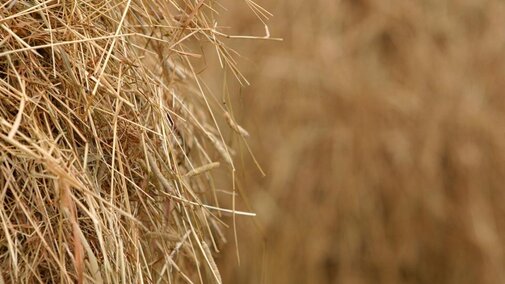Deciphering a Hay Test: ADF and NDF
By Brad Schick
Understanding a hay test can be difficult. Today, we will look at fiber tests — Acid Detergent Fiber, or ADF, and Neutral Detergent Fiber, or NDF.
Both ADF and NDF are part of the detergent analysis system used to analyze forages. NDF provides us with a measure of the forage sample’s cell wall, basically the total fiber. This includes the cellulose, hemicellulose, lignin and silica portions of the forage, which are the primary structural components for all plants. ADF, on the other hand, measures only the least digestible parts of the plant: cellulose, lignin and silica.
NDF measurements correspond with voluntary intake and rumen fill, how much and how fast an animal can eat. They also are a measure of how much energy is available to the animal. Usually, a low NDF reading means more energy available to the animal. The more mature a plant becomes, the more structural components it accumulates, resulting in higher NDF readings and poorer quality feed. NDF levels can vary from 80% in straw to less than 40% in early blooming alfalfa.
ADF is directly related to the digestibility of the feed, measuring the indigestible portion of the plant. As ADF increases, digestibility decreases. This means that high ADF forages are low in energy. Alfalfa at early bloom has an ADF of 30-35%, while a late bloom alfalfa has an ADF usually above 40%. Straw will have an ADF nearer to 50%.
ADF and NDF measure the sample’s fiber content, affecting digestibility and forage intake, which help predict animal performance. Understanding these values set us up for the next discussion as we look at a measure of energy — TDN.
High Quality Hay After Calving
Good cow nutrition is crucial following calving to get cows rebred. Today, let's look at the reason for using our top tier hay after calves hit the ground.
Because cows experience a lot of stress after calving, they need good feed. Not only is the cow producing milk for her calf, she is also preparing her reproductive system to rebreed. As a result, nutrient demands are high. Energy requirements increase about 30% and protein needs nearly double after calving. Underfeeding reduces the amount of milk a cow provides her calf, and it can delay or even prevent rebreeding. If it gets cold, wet or icy again, nutrient demands can sky-rocket.
Even if they can get to them, winter grass, cornstalks and other crop residues are low quality right now as these feeds have weathered and are well picked over. It is critical that the hay or silage you feed will provide the extra nutrients your cows need.
Because of this, not just any hay or silage will do. Your cow needs 10% to 12% crude protein and 60% to 65% TDN in her total diet. If she is grazing poor quality feeds or eating grass hay, your other forages and supplements must make up any deficiencies.
Make sure your forage has adequate nutrients — if you haven't done so yet, get it tested now for protein and energy content. Compare this to the nutrient requirements of your cows. Then feed your cows a ration that will meet their requirements. Use supplements if needed, but don't overfeed, either. That is wasteful and expensive.
Calving and the months after are a stressful time for cows. If we underfeed, it can delay rebreeding and slow down calf growth. Use your best quality forages with any needed supplements to provide adequate nutrition. By meeting nutrient requirements, your cows will milk well, rebreed on time and produce healthy calves year after year.

